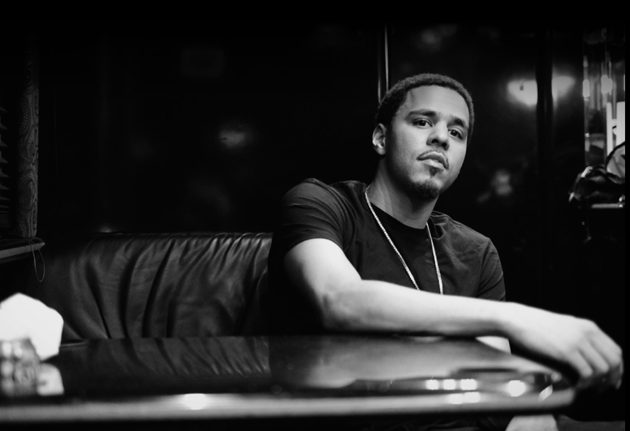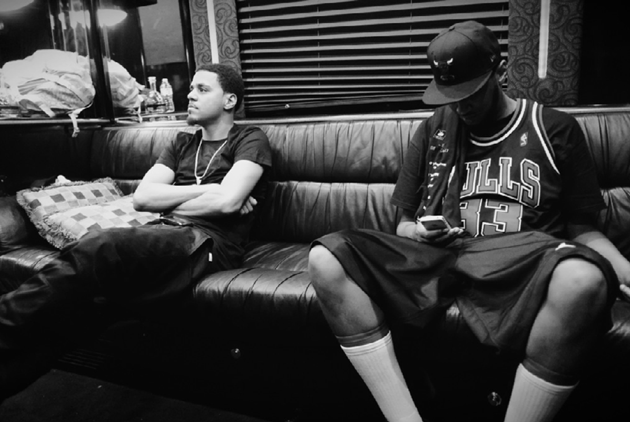 Music
Music
J. Cole and the quest to be hip-hop's biggest and best
by Chayne Japal
August 26, 2013
What does it take to be #1 in the game? J. Cole's a contender—and Blake Carrington and JD Era weigh in on the process.
In 2007 in New York City, a new St. John’s University communications grad released a mixtape. Its debut single, “Simba,” says, “I can’t wait to be the king,” a brash boast and grandiose sense of entitlement that’s practically a prerequisite for a young rapper. The one in question has since done a fair bit more than just wait to be crowned.
Jermaine Cole, originally from Fayetteville, North Carolina, set up shop in New York City to get that degree, and then, to pursue music. After that first tape The Come Up, a handful of polished new recordings started making their way to the right ears, eventually finding Jay Z’s. Cole was signed to Jay’s then-brand-new Roc Nation imprint, immediately using the signing momentum to start a trilogy of sports analogy titled releases with The Warm Up, a title that betrayed how ready he was.
Striking a balance between his story and his storytelling, charisma and shyness, youth and wisdom, hot spit and detailed production, J. Cole immediately drew a broad demographic of hip-hop fans. They began making the case for him, and Cole supplied them with evidence, one verse at a time. With every successful release—most recently his Billboard-topping sophomore album, Born Sinner, he gets closer to his lofty aspirations, but there’s a volatile aspect to his ascension to all-time dominance, and it’s mostly out of his control. Simply put, at this current juncture, J. Cole is not the undeniable king of hip-hop. And it’s not necessarily his fault.
The high-calibre music that Cole and his peers have been releasing thus far in the 20-teens has made the never-ending debate about as blurry as it can be. Rappers thrive on competition and the current flourishing state of hip-hop can collectively help bring everyone closer to where they want to be. When it’s all said and done, this will play a major part in determining Cole’s place in rap history. But there have been instances where promising talents have become more concerned with competition than their music, falling victim to the very thing that fuels them.

To his credit, J. Cole completed one daunting task during his early career, something that incredible talents like Beanie Sigel and Memphis Bleek never quite maneuvered—escaping the shadow of his boss, Jay Z. Even though Jay isn’t as formidable as he was during Roc-A-Fella’s heyday, he remains a cultural icon, whose support is somewhat of a catch-22. There are a few exceptions, especially with the viral breakout possibilities of the internet (Macklemore), but when it comes to a major label artist like Cole, who moves the amount of units he does, there tends to be an initial co-sign from a prominent artist to give the young artist some traction (Dr. Dre put Eminem on, Eminem put 50 Cent on, 50 Cent put The Game on, etc.). Jay Z’s co-sign should prove invaluable to an up-and-comer, but it gets tricky.
Similar to J. Cole, Toronto’s JD Era was signed by a legend, Raekwon, and has the task of rising out of those shadows he so admires, but he’s up to it. “I don’t care if Raekwon’s beside me. I’m in it to be #1,” he says on the phone from a studio in NYC. “Our nature as MCs is to be the best. It’s a sport. It really is. In basketball, LeBron comes and does a tomahawk, the other guys are looking at him like, ‘forget his tomahawk, I got a windmill.’ That’s just how it is.”
As much as this is all part of the essence of hip-hop, it puts an immense amount of pressure on the untested musician as comparisons to their more established counterparts create unfair expectations. During a recent appearance in Toronto on his Dollar And A Dream Tour, Cole prefaced “Sideline Story,” the semi-title track from his 2011 debut, Cole World: The Sideline Story, with a few thoughts on how he felt while recording that project. “I was just stressed, man,” he recalls with a sigh. He seems relieved that he made it through. Cole World carried that pressure at its core, turning into a hodgepodge of radio-ready singles, old mixtape cuts, and a somewhat forced appearance by executive producer Jay Z, alongside a few tracks that felt right. Had Cole not proven himself before on the aforementioned mixtapes and Friday Night Lights (which, at the same show, he conversely said he was “in the zone” for), this could have ruined his confidence. Instead,he got back to work, shedding himself of his mentor for the far superior Born Sinner. Even though his debut had to be, in a sense, sacrificed to prove it, J. Cole doesn’t need Jay-Z to help him make a good album.

Another Toronto rapper, Blake Carrington, has some thoughts on where competition could go awry. “There’s a difference between competition and pride”, he says. “Rappers don’t learn from their failure. They just stay laying in it, basting in it. That’s how they become bitter.”
An example of this is the trajectory of one of Cole’s favourite artists and key influencers, Canibus. With a two-year streak of jaw-dropping guest spots starting in 1996, he was soon ordained a hip-hop saviour, and then he started beefing with LL Cool J over lyrics. Canibus’ first single as a solo artist ended up being “2nd Round K.O.,” a classic diss track that chewed into LL.
While it raised publicity for Canibus, the conversation became less about him and more about the drama. By the time his Wyclef Jean-produced debut was released in the late summer of 1998, he had lost his steam and the album fell flat. By his second album, Canibus’ fate was sealed, and even if he has bars until the end of the world, he wasn’t making hits and couldn’t offer up the perfect album people expected. Canibus went on to blame Wyclef for his mainstream failure, moving on to the underground market, leaving a lesson for other promising artists that have followed. J. Cole has steered clear of these situations. Though he’s been lured (Diggy Simmons and even Canibus himself have come looking for trouble), he’s refused to feed into any negativity. Coming off the critical disappointment of his debut album, he’s made adjustments and moved on without complaining or attacking.

Groundbreaking albums Doggystyle, Enter The Wu-Tang, Midnight Marauders, Enta Da Stage, Southernplayalisticadillacmuzik, The Sun Rises In The East, Creepin On Ah Come Up, Ready To Die, The Diary, and Hard To Earn were all released in a 12-month span,.harkening back to a time when hip-hop was unassailably its most potent. The album that defines the period, Nas’ debut Illmatic, became an instant classic that has remained the blueprint for how to craft a perfect hip-hop album. There’s an air of mystique surrounding this album and attempts to recapture its essence are futile—the greatest album of the golden era will be greatest of all time.
That’s the task set for the current bunch to tackle as a group. Acts like Kendrick Lamar, Earl Sweatshirt, and Big K.R.I.T. to name a few, reinforce what J. Cole is trying to do by trying to do it themselves, and providing healthy competition; pushing each other to work harder and by default, all delivering stronger music. Cole hasn’t lost his own story though, and the essence of hip-hop makes it more than a style of music—it is a story. It weaves and twists as heroes and villains rise and fall. J. Cole has written himself in, and he’s eyeing the leading role.

This article originally appeared in the August 2013 Issue of AUX Magazine.
Download and subscribe for free in the app store.
Tags: Music, News, AUX Magazine, Blake Carrington, J Cole, JD-Era





